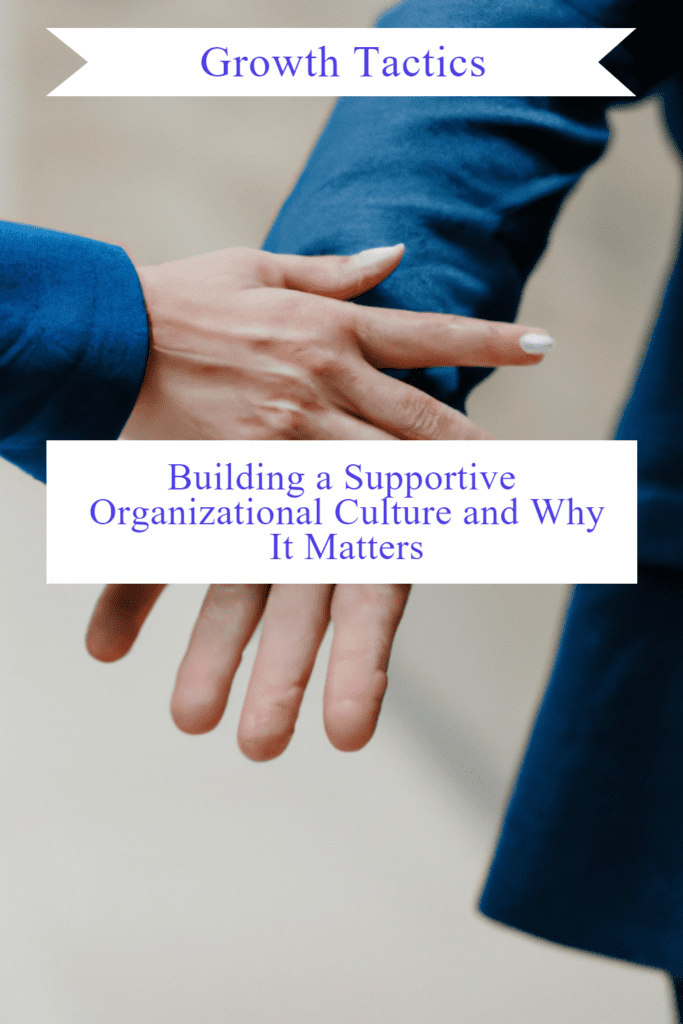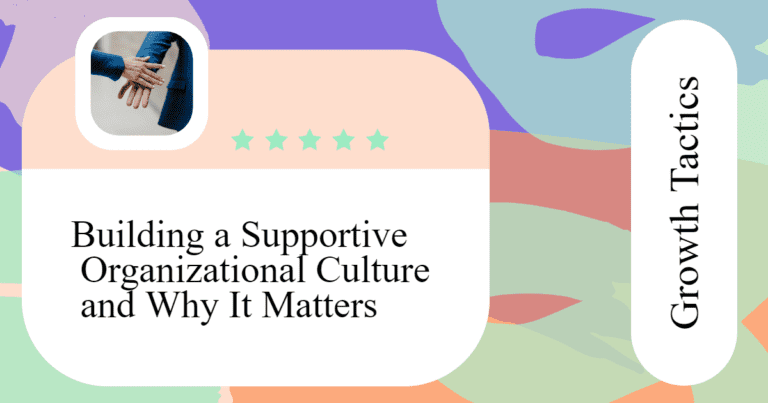Creating a supportive workplace culture is not just a noble cause but a vital aspect of your business’s survival in a shifting corporate landscape. This in-depth article will provide valuable insights into why cultivating such a culture provides a competitive edge and how it leads to decreased employee turnover, improved job satisfaction, and ultimately, increased productivity within your organization.
Jump To Section
What is Company Culture and Why Does it Matter?
Company culture is an organization’s DNA. The values, beliefs, shared assumptions, and collective behavior patterns that shape the work environment and the employee experience within a company. It represents the essence of an organization, providing a framework that guides employee actions, interactions, and decision-making.
Now that we’ve defined company culture, let’s find out why it matters so much:
- Enhanced productivity: A strong company culture has the potential to increase productivity. When employees feel aligned with the organization’s values and vision, they are more likely to be engaged in their work, performing better as a result.
- Employee satisfaction and retention: A great culture makes the workplace enjoyable, motivating employees to stay with the company for the long haul. High employee satisfaction levels and lower turnover rates save the organization valuable resources in recruiting and training new employees.
- Positive brand reputation: A supportive and vibrant company culture naturally creates a positive image for your business, attracting top talent in the industry and fostering loyal customers who appreciate what your company stands for.
- Adaptability and resilience: A robust company culture fosters a sense of unity and solidarity within your organization, better equipping your team to face challenges, adapt to changes, and bounce back stronger after setbacks.
So, company culture is not merely a supporting actor in the corporate world, it’s a crucial element necessary to create a thriving business. Focusing on your organization’s culture and nurturing its growth will help you build an environment where employees are more engaged, satisfied, and committed to ensuring the sustained success of your company.
What Does a Supportive Workplace Look Like?
Several key traits characterize such an environment:
- Open Communication: At the heart of a supportive workplace is the freedom to share thoughts, ideas, and concerns. Employees feel their contributions are valued, and they are encouraged to voice their opinions. Open communication fosters mutual respect, promotes better teamwork and collaboration, and enables efficient problem-solving.
- Trust and Respect: A supportive work culture is an embodiment of the ethos of trust and respect among all employees, irrespective of their roles. It’s about acknowledging everyone’s importance in the overall organizational performance and treating each other with dignity.
- Recognition and Appreciation: An environment where individual achievements are recognized and celebrated fuels job satisfaction. Team members know that their efforts are noted and appreciated, which, in turn, encourages them to put in their best work.
- Employee Development Opportunities: A supportive workplace culture is incredibly invested in its staff’s personal and professional growth. It encourages continuous learning through training, webinars, workshops, and mentorship programs, thereby promoting long-term employee loyalty and job satisfaction.
- Work-life Balance: More than ever before, employees value companies that prioritize their mental health and well-being. One of the most critical ways they do this is by promoting a healthy work-life balance, offering flexible work arrangements, providing access to mental health resources, and encouraging team members to take time to recharge.
- Inclusiveness and Diversity: A supportive workplace embraces differences, providing equitable opportunities for all employees, irrespective of their gender, race, religion, or age. Diversity brings fresh perspectives and ideas, fostering creativity and innovation.
A supportive workplace provides a safe space to work, innovate, and grow, and is the foundation for both a company’s and an employee’s success. It acknowledges that companies are not just made up of employees. They are made up of uniquely valuable human beings deserving respect and encouragement.
What Key Traits do We Need to Create a Supportive Culture Within our Organization?

Imagine, as a seasoned business leader, you’re presented with the task of creating a supportive company culture in your organization. You might wonder where to start, so let’s discuss some key traits of a supportive culture.
Creating a supportive culture within your organization isn’t an overnight transformation, but a gradual process that requires consistent effort, thoughtfulness, and participation from everyone, right from the leadership team to the last employee in the chain. Here’s how you can build a supportive culture within your organization:
1. Set Clear and Inclusive Core Values
Every organization needs a set of core values to guide its people. But merely having them isn’t enough; they need to be clearly articulated, widely understood, and, most importantly, inclusive. Demonstrating these values in the company’s day-to-day behaviors is a powerful indicator of a supportive work culture.
2. Open Communication Channels
A supportive workplace thrives on transparency and open dialogue. To foster an environment of trust and mutual respect, encourage open lines of communication at all organizational levels. Implementing an open-door policy and actively seeking feedback solicitation can be a big driving force in this regard.
3. Walk the Talk on Diversity and Inclusion
Promote diversity and inclusion in every sense of the word. Embracing differences can bring unique perspectives and foster additional creativity within the organization. Developing dedicated policies and inclusion programs ensures these practices take root in the company’s culture.
4. Invest in Employee Growth and Well-being
Show your employees that their growth matters to you. Focus on upskilling initiatives, mentorship programs, and continuous learning opportunities. In conjunction with fostering professional development, pay attention to employees’ mental health by promoting work-life balance, providing health and well-being programs, and training managers to address these critical facets.
5. Provide Recognition and Praise
Everyone wants to feel valued and acknowledged for their efforts. Implement a robust system for recognizing and praising employee achievements. Appreciating employees for their hard work not only boosts their morale but also nurtures a collaborative and supportive culture.
6. Cultivate Strong Leadership
The tone for a supportive culture is set at the top. Ensure your leadership embodies the very values you are trying to instill. Leaders should aim to inspire trust and confidence in their teams, fostering a sense of empowerment and autonomy among employees.
Remember, building a supportive culture is more than just following a checklist; it’s about nurturing an environment that values the perspectives and contributions of each team member. As you create a supportive culture within your organization, you are not just investing in your company’s present, but also setting the tone for a successful, sustainable future.
The Impacts of Supportive Workplace Culture on Turnover
A supportive organizational culture, one that prioritizes transparency, open communication, appreciation, and personal growth, leads to a crucial element that all businesses seek: increased employee loyalty. Employees, when they feel heard, recognized, and supported, tend to align themselves more profoundly with the organization. They enjoy their work, feel a part of the larger vision, and are less likely to look for opportunities outside, consequently reducing turnover rates.
On the other hand, a lack of supportive culture can lead to discomfort, dissatisfaction, and eventually, high turnover rates. High staff turnover is not only expensive due to the costs associated with recruitment, onboarding, and training of new hires, but it also takes a toll on overall team morale. The constant flux of team members may lead to instability within teams, disrupting workflows, and possibly eroding customer satisfaction.
That’s why I believe a supportive organizational culture is not just good-to-have, but a must-have. It directly impacts your company’s turnover rates and, subsequently, its overall performance and reputation. As experienced leaders, it deserves our focus and consistent efforts to ensure the longevity and success of our teams and organizations.
The Role of Leadership in Shaping Company Culture

The role of leadership within an organization is more than just making strategies and overseeing operations. Leaders are, in every substantial sense, the architects of the company culture. Their behaviors, decisions, and communication styles set the tone for the rest of the organization.
They are instrumental in establishing the core values, nurturing a sense of unity, and promoting an environment where every employee feels valued. Moreover, their ethos trickles down through all levels of the organization, influencing overall attitudes, behaviors, and interactions within the team.
Let’s consider this: Employees look up to their leaders, not just for direction, but for inspiration. When leaders set an example by embodying the core values they promote, they create a positive ripple effect that instills these values in their teams.
Leaders who encourage open communication, show respect, appreciate hard work, and foster a healthy work environment, in turn, cultivate teams that mirror these characteristics. A leader’s investment in creating a supportive, engaging, and inclusive environment helps to cultivate a strong company culture, steering the organization toward continued success.
In essence, effective leaders don’t just influence the work; they shape the workplace culture itself. Leadership and organizational culture are, thus, intimately connected, each one reinforcing and driving the other. As we continue our roles as leaders, let’s remember the profound impact our actions and decisions can have on the company culture we are striving to create.
Balancing Productivity and Employee Wellness

It’s true, productivity is essential for the success of any organization; after all, it’s the driving force that generates results. However, focusing solely on productivity without addressing employee wellness can have detrimental effects in the long run. A healthier, more balanced workforce leads to improved work quality, greater job satisfaction, and ultimately, enhanced overall performance.
So, how can we, as seasoned leaders, successfully steer our organizations to balance productivity and employee wellness? It starts with acknowledging the connection between the two and taking a more holistic approach to our management strategies.
Firstly, one of the most impactful ways to support employee wellness is by creating a flexible work environment. Offering options such as remote work, flexible hours, and adaptable schedules enables employees to manage their personal and professional lives more seamlessly. This, in turn, can lead to increased motivation and well-being, driving productivity even further.
Secondly, fostering a culture that encourages open dialogue enables employees to share their experiences and ideas and feel more connected and supported within their workplace. This sense of connection not only enhances well-being but also inspires employees to be more creative and productive.
Lastly, their physical and mental health should be prioritized, as investing in employee wellness programs can directly impact productivity. These initiatives can range from stress management workshops, gym memberships, and access to mental health resources. By supporting the well-being of our workforce, we are also nurturing their ability to perform at their best.
Balancing employee wellness and productivity is a crucial, albeit delicate, act for business leaders. Understanding the interconnectedness of these two elements and proactively incorporating strategies that prioritize both aspects will yield a healthier and more productive workforce, setting the stage for the long-term success of our organizations.
How to Ensure the Sustainability of Your Cultural Shift and Drive Organizational Success

Creating a supportive culture in an organization is a significant undertaking, but once established, its sustainability is equally vital. Sustainability ensures that the efforts you’ve invested in not only maintain momentum but also continue to enhance your organization’s operational dynamics. Here are some strategies that can help secure the sustainability of your cultural shift:
1. Maintain Consistency in Core Values
The core values that form the foundation of your cultural shift should be steadfast and consistently underscored in every aspect of organizational behavior, from management practices to daily operations. This consistency reinforces the acceptance and integration of these values into the mindset of the employees.
2. Continual Communication
Communication is the sustenance your cultural shift requires to thrive. Continually articulate and promote the tenets of your desired culture through various channels. Clear communication fosters alignment, and it’s this alignment to the cultural shift that ensures its sustainability.
3. Empower Employees
Empower your employees to be the torchbearers of your cultural change. Encourage them to actively participate in translating the cultural shift into their responsibilities, thereby making them integral parts of this transformation.
4. Incorporate Feedback Mechanisms
Build mechanisms to gather employee feedback on the cultural shift. Honest feedback offers insights into how effectively the cultural transformations have been adopted by your employees and where fine-tuning might be required.
5. Reinforce through Recognition and Rewards
Highlight and reward behaviors that align with the cultural shift. When employees see that their adherence to the new culture is being recognized and appreciated, they are more likely to sustain those behaviors.
6. Lead by Example
As leaders, your actions set the tone for your team. Embody the changes you wish to see and consistently demonstrate behaviors that are emblematic of your new culture. Leaders living the change inspire all levels of the company to emulate the same.
Remember, a cultural shift isn’t a sprint to the finish line but rather a marathon of continual adjustments, engagement, and reinforcement. It is a gradual process that, when nurtured over time, can lead to compounding benefits, making your organization a more supportive, inclusive, and productive environment.


